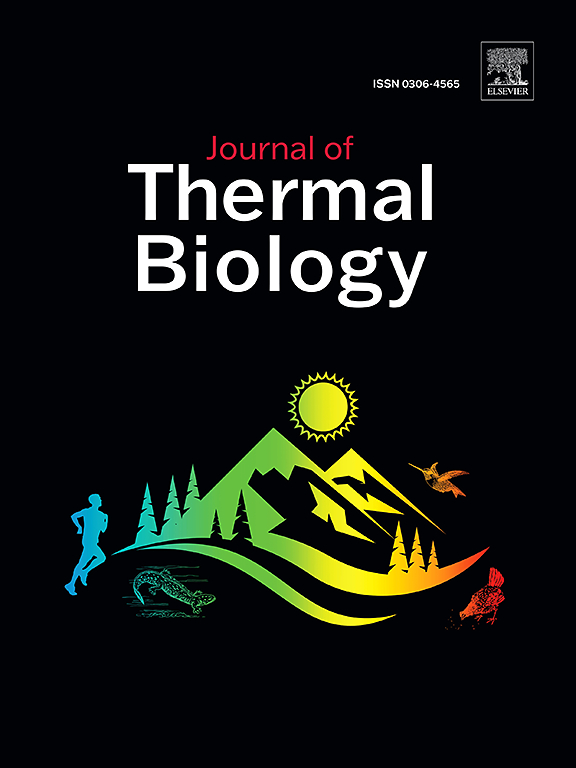非冬眠动物 Nyctalusnoctula 冬季活动中温度和昼夜节律周期性的相互作用。
IF 2.9
2区 生物学
Q2 BIOLOGY
引用次数: 0
摘要
冬眠哺乳动物的冬季活动很可能受到气候变化的影响。我们的研究重点是夜蝙蝠(Nyctalus noctula),它是一种非冬眠动物,在一个新近殖民的冬季地区使用人工栖息地。通过连续的声学监测和栖息地内外的温度测量,我们发现蝙蝠即使在冬眠季节也表现出昼夜节律周期(夜间活动,白天休息)。活动持续时间和强度随环境温度、光周期和冬眠进程而变化。温暖的环境温度导致夜间活动增加,从而延长了活动阶段的持续时间。随着光周期的延长,休息阶段也随之延长,而从冬眠期开始到结束,总体活动强度有所下降。温度低于 0 °C时,蝙蝠的声音活动几乎为零,这表明蝙蝠在白天和夜晚的活动概率都很小。该物种最近成功地将冬眠范围向北扩展,这可能要归功于它能灵活地适应当时的环境条件。尽管如此,在温度高于0 °C的情况下进行日常活动是否会给北纬地区的蝙蝠带来任何好处以防止过早的能量消耗,这一点仍不确定。冬季持续的昼夜节律活动可能是一种遗存行为,是从昆虫丰富和温暖的南纬地区过冬的历史模式中适应而来的。本文章由计算机程序翻译,如有差异,请以英文原文为准。
The interplay of temperature and circadian periodicity in winter activity of non-cavernous hibernator, Nyctalus noctula
Winter activity of hibernating mammals is likely to be influenced by climate change. Our study focuses on Nyctalus noctula, a non-cavernous hibernator using artificial roosts in a recently colonized winter region. Using continuous acoustic monitoring and temperature measurements inside and outside the roosts, we found that bats exhibit a circadian cycle (active at night, resting during the day) even during hibernation season. Activity duration and intensity changed in response to ambient temperature, photoperiod, and hibernation progression. Warm ambient temperatures led to increased nighttime activity, extending the duration of the active phase. As photoperiod increased, the rest phase lengthened, while the overall magnitude of activity decreased from the beginning to the end of the hibernation period. Below 0 °C vocal activity was nearly zero indicating a minimal probability of bat activity during both day and night. The species recent success in extending its hibernation range northward may be attributed to its flexible adjustment to prevailing environmental conditions. Nevertheless, it remains uncertain whether engaging in daily activity at temperatures above 0 °C confers any advantages at northern latitudes to prevent premature energy depletion. The persistence of circadian activity during winter could be a relic behavior, adapted from historical patterns of wintering in insect-rich and warm southern latitudes.
求助全文
通过发布文献求助,成功后即可免费获取论文全文。
去求助
来源期刊

Journal of thermal biology
生物-动物学
CiteScore
5.30
自引率
7.40%
发文量
196
审稿时长
14.5 weeks
期刊介绍:
The Journal of Thermal Biology publishes articles that advance our knowledge on the ways and mechanisms through which temperature affects man and animals. This includes studies of their responses to these effects and on the ecological consequences. Directly relevant to this theme are:
• The mechanisms of thermal limitation, heat and cold injury, and the resistance of organisms to extremes of temperature
• The mechanisms involved in acclimation, acclimatization and evolutionary adaptation to temperature
• Mechanisms underlying the patterns of hibernation, torpor, dormancy, aestivation and diapause
• Effects of temperature on reproduction and development, growth, ageing and life-span
• Studies on modelling heat transfer between organisms and their environment
• The contributions of temperature to effects of climate change on animal species and man
• Studies of conservation biology and physiology related to temperature
• Behavioural and physiological regulation of body temperature including its pathophysiology and fever
• Medical applications of hypo- and hyperthermia
Article types:
• Original articles
• Review articles
 求助内容:
求助内容: 应助结果提醒方式:
应助结果提醒方式:


